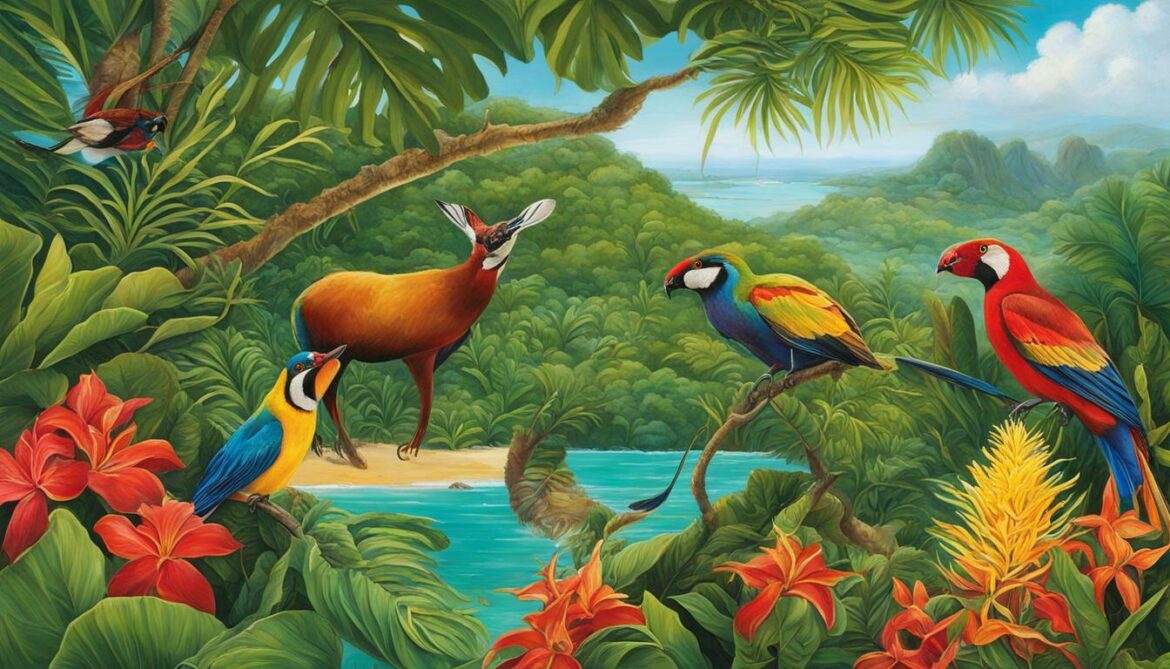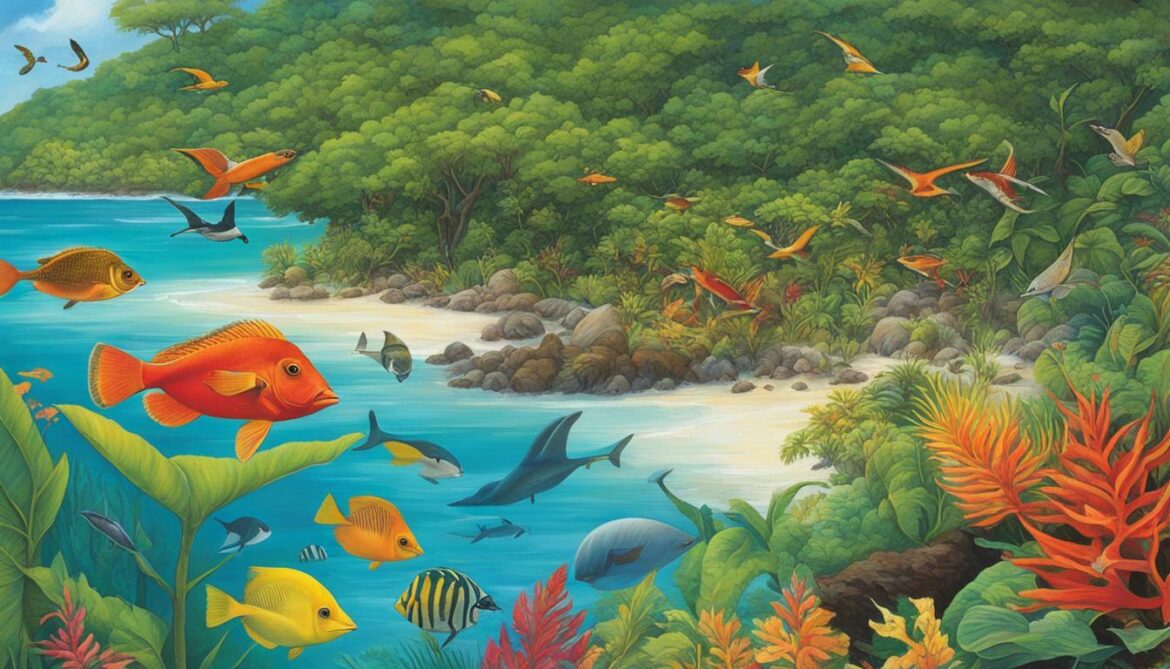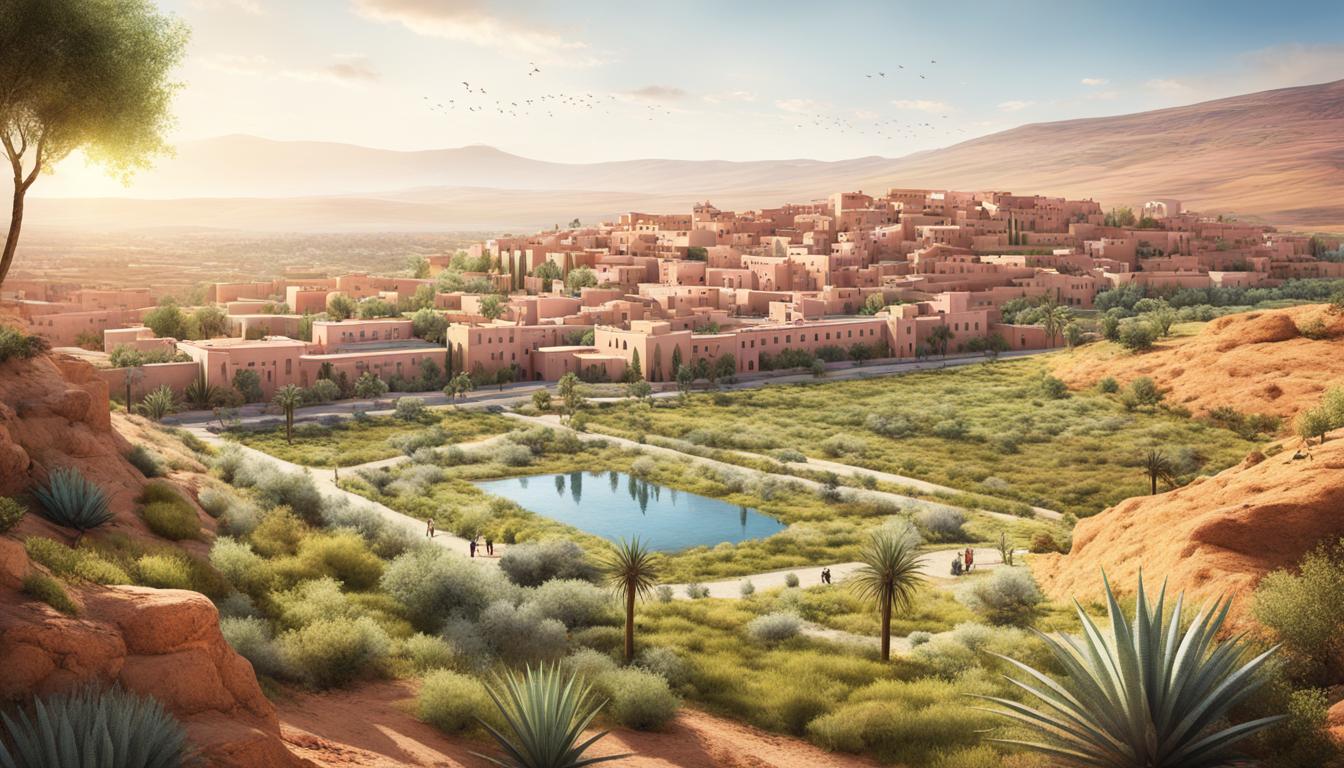Barbados Biodiversity: Animal and Plant Species and What Is Under Threat
Barbados is home to a diverse range of animal and plant species, making it a biodiversity hotspot in the Caribbean. From its stunning flora to its unique wildlife, Barbados’ ecosystem is rich with natural wonders. However, this precious biodiversity is under threat due to various factors, including human activity and development.
Key Takeaways:
– Barbados is known for its rich biodiversity, with a wide variety of animal and plant species.
– The island is home to approximately 700 species of flowering plants, 201 bird species, 15 mammal species, 8 reptile species, and 2 amphibians.
– Barbados has a relatively low number of endemic species, but its marine biodiversity is comparatively high, with around 50 hard corals and almost 600 fish species.
– The rapid development and high population density in Barbados pose challenges to the preservation of its biodiversity, as human activities encroach upon natural habitats.
– International travel and trade have also introduced invasive species, which can have adverse effects on the local biodiversity.
– The Ministry of Environment in Barbados has implemented the Biodiversity Conservation and Management Programme to address these challenges and promote the conservation and sustainable use of biodiversity.
– The programme focuses on species management, public awareness and education, multilateral environmental agreement implementation, and project development.
– As the CITES Management Authority, the programme is responsible for regulating the international trade of endangered species, issuing permits, and promoting public awareness.
– Public awareness and education initiatives, such as Biodiversity Day and Land Degradation Day, aim to engage the community in biodiversity conservation.
– The programme also collaborates with schools and NGOs to undertake projects related to biodiversity and sustainable land management.
– Barbados is committed to fulfilling the provisions of international agreements such as the Convention on Biological Diversity and the Convention on International Trade in Endangered Species of Wild Fauna and Flora.
Remember to insert the image with the provided link using the tag: . Place the image in the center for visual appeal.
What is Biodiversity?
Biodiversity, also known as biological diversity, encompasses the variety of genes, species, and ecosystems found within a specific region. It refers to the intricate web of life on Earth, including everything from the smallest microorganisms to the largest mammals.
Genes are the building blocks of life and carry the genetic information that determines the characteristics of organisms. Species are a group of organisms that share similar traits and are capable of interbreeding. Ecosystems are dynamic communities of organisms interacting with each other and their environment, including the physical and biological components.
“Biodiversity is the variety of the world’s organisms, including their genetic makeup and the communities they form.”
Why is Biodiversity Important?
Biodiversity is crucial for the functioning of ecosystems and essential for the well-being of all life on Earth. It provides numerous ecosystem services, such as clean air and water, pollination of crops, regulation of climate, and the provision of food, fiber, and medicine. Biodiversity also contributes to the aesthetic, cultural, and recreational value of our planet.
“Barbados’ biodiversity has enormous importance in all aspects of human life, from food and medicines to industrial and agricultural products, as well as for recreation and tourism.”
| Component | Number of Species |
|---|---|
| Flowering Plants | Approximately 700 |
| Birds | 201 species |
| Mammals | 15 species |
| Reptiles | 8 species |
| Amphibians | 2 species |
| Marine Biodiversity | Approximately 50 hard corals and almost 600 fish species recorded |
Barbados is home to various plant and animal species, contributing to its rich biodiversity. However, the island’s limited land area and high population density pose challenges to the conservation of its unique flora and fauna.

“Barbados is a rapidly developing island state with one of the highest population densities in the world, which means that the relatively limited biodiversity and natural habitats are constantly under threat from human activity and development.”
Human activities, such as urbanization, tourism development, and the introduction of invasive species, have adverse effects on Barbados’ biodiversity. These impacts can lead to the loss of habitats, the decline of native species, and disruption of ecosystems.
It is crucial to prioritize the conservation and sustainable use of Barbados’ biodiversity to ensure its long-term survival and the well-being of both the natural environment and human communities.
The Current Status of Biodiversity in Barbados
Barbados boasts an impressive array of biodiversity, with approximately 700 species of flowering plants, 201 bird species, 15 mammal species, 8 reptile species, and 2 amphibian species. This diverse range of flora and fauna contributes to the country’s natural beauty and plays a vital role in various aspects of human life, including food production, medicine, and tourism.
According to the IUCN Red List, there are several Critically Endangered species in Barbados, including the Barbados Cedar (Juniperus barbadensis var. barbadensis), Barbados Skink (Alinea lanceolata), and Barbados Leaf-toed Gecko (Phyllodactylus pulcher). These species face significant threats to their survival and require urgent conservation efforts to prevent their extinction.
The marine biodiversity in Barbados is also noteworthy, with approximately fifty hard corals and nearly six hundred fish species recorded. These marine ecosystems are essential for supporting coastal economies, providing habitat for numerous species, and supporting the livelihoods of local communities.
Unfortunately, Barbados’ biodiversity faces numerous threats due to human activity and development. The island’s small size, high population density, and well-developed physical infrastructure contribute to the constant encroachment on natural habitats. The expansion of tourism, residential and commercial development, and intensive monoculture agriculture pose significant risks to the country’s biodiversity.
| Flora | Fauna |
|---|---|
| Approximately 700 species of flowering plants | 201 bird species |
| 15 mammal species | |
| 8 reptile species | |
| 2 amphibian species |
Quote:
“Barbados boasts an impressive array of biodiversity, with approximately 700 species of flowering plants, 201 bird species, 15 mammal species, 8 reptile species, and 2 amphibian species.”

In response to these threats, the Ministry of Environment in Barbados has implemented the Biodiversity Conservation and Management Programme. This program aims to effectively manage biodiversity and land resources, particularly in degraded areas, and increase awareness of the importance of local biodiversity for sustainable development.
The Biodiversity Conservation and Management Programme is focused on various activities, including the development of legislative instruments, the implementation of plans and projects, and the promotion of public awareness and education. The program also fulfills the role of the CITES Management Authority, responsible for regulating the international trade in endangered species of wild fauna and flora.
Through these efforts, Barbados aims to conserve and sustainably use its biodiversity, ensuring the protection of unique plant and animal species, and promoting environmental stewardship for future generations.
Impacts on Barbados’ Biodiversity
As a rapidly developing island state, Barbados faces the challenge of balancing progress with the preservation of its limited biodiversity, as human activity and development encroach upon natural habitats. The well-developed physical infrastructure, high population density, and various types of development, including tourism, residential, and commercial projects, pose significant threats to the country’s biodiversity.
One of the main impacts on Barbados’ biodiversity is habitat loss and fragmentation. As land is cleared for infrastructure and urbanization, natural habitats are destroyed or fragmented, leading to the displacement and loss of many plant and animal species. The development of golf courses, tourism resorts, and other infrastructure projects further contributes to the degradation of natural habitats.
Invasive species also pose a significant threat to Barbados’ biodiversity. International travel and trade have facilitated the introduction of non-native species, which can outcompete native species for resources and disrupt local ecosystems. These invasive species can have devastating impacts on Barbados’ biodiversity, leading to the decline or extinction of native flora and fauna.
| Impact on Barbados’ Biodiversity | Examples |
|---|---|
| Habitat loss and fragmentation | Clearance of land for development, urbanization, and infrastructure projects |
| Invasive species | Introduction of non-native species through international travel and trade |
“Barbados’ well developed physical infrastructure including our transport networks and one of the highest population densities in the world means that the relatively limited biodiversity and natural habitats are constantly under threat from the encroachment of human activity.” – Ministry of Environment, Barbados
Efforts are being made by the Ministry of Environment in Barbados to mitigate the impacts on biodiversity. The Biodiversity Conservation and Management Programme aims to conserve and sustainably use the country’s biodiversity through various initiatives. These include the development of legislative instruments, the implementation of plans and projects, and the promotion of public awareness and education.
The Role of the Biodiversity Programme
As the CITES Management Authority, the Biodiversity Programme plays a crucial role in regulating the international trade in endangered species of wild fauna and flora in Barbados. It issues permits for the importation, exportation, and re-exportation of endangered species, maintains records of trade, and assesses the adequacy of importers. The Programme also works towards raising public awareness and educating the public about the importance of biodiversity conservation and sustainable use.
By implementing the goals and objectives of the Biodiversity Conservation and Management Programme, Barbados aims to safeguard its unique biodiversity, protect natural habitats, and promote sustainable development for the benefit of present and future generations.

The Ministry of Environment’s Response
The Ministry of Environment in Barbados is dedicated to the conservation and sustainable use of biodiversity and works collaboratively with various stakeholder groups to achieve these goals. As a small island developing state, Barbados recognizes the importance of preserving its unique flora and fauna, as well as its ecosystems, for the well-being of its people and the future generations.
One of the key initiatives undertaken by the Ministry is the Biodiversity Conservation and Management Programme. This program aims to effectively manage the biodiversity and land resources of Barbados, particularly in degraded areas. It recognizes the significance of local biodiversity and land resources in contributing to local development and seeks to increase awareness of their importance.
The Biodiversity Conservation and Management Programme implements a range of activities to achieve its objectives. These activities include the development of legislative instruments, the implementation of plans, programs, and projects, as well as the fulfillment of obligations under multilateral environmental agreements. The program focuses on species management, public awareness and education, multilateral environmental agreement implementation, and project implementation and development.
The Role of the Biodiversity Programme
As the CITES Management Authority, the Biodiversity Programme in Barbados plays a crucial role in regulating and monitoring the international trade in endangered species of wild fauna and flora. It issues permits for the importation, exportation, and re-exportation of these species, maintains records of trade, and assesses the adequacy of importers. The program also promotes public awareness and education regarding biodiversity conservation and sustainable use.
“Conservation is a key pillar of sustainable development,” says Minister of Environment in Barbados, “and we are committed to ensuring the conservation and sustainable use of our biodiversity. By working together with stakeholders and implementing effective management strategies, we can protect our unique flora and fauna for future generations.”
| Conservation Initiatives | Key Objectives |
|---|---|
| Species Management | To conserve and manage endangered and endemic species |
| Public Awareness and Education | To increase awareness of the importance of biodiversity and sustainable land management |
| Multilateral Environmental Agreement Implementation | To fulfill obligations under international environmental agreements, such as the Convention on Biological Diversity and CITES |
| Project Implementation and Development | To implement projects and develop strategies for biodiversity conservation and sustainable use |
The Ministry of Environment in Barbados is committed to ongoing efforts in biodiversity conservation and sustainable use. Through the Biodiversity Conservation and Management Programme and collaborative partnerships with stakeholders, Barbados aims to protect its unique biodiversity and ensure its long-term sustainability.

The Biodiversity Conservation and Management Programme
The Biodiversity Conservation and Management Programme in Barbados aims to effectively manage biodiversity and land resources through the development of legislative instruments, the implementation of plans and projects, and the adherence to multilateral environmental agreements. The objective of the programme is to undertake the conservation and sustainable use of biodiversity and land resources, particularly in degraded areas of Barbados, while increasing awareness of the importance of local biodiversity and land resources in contributing to local development.
The programme focuses on various activities to achieve its objectives. These include the development and implementation of legislative instruments, the formulation and execution of plans, programmes, and projects, and the fulfillment of obligations under multilateral environmental agreements. These efforts are aimed at promoting the conservation and sustainable use of biodiversity in Barbados.
One of the key responsibilities of the Biodiversity Conservation and Management Programme is to serve as the CITES Management Authority. Barbados is a Party to the Convention on International Trade in Endangered Species of Wild Fauna and Flora (CITES), and the programme plays a crucial role in ensuring the control of international trade in endangered species. It issues permits for the importation, exportation, and re-exportation of endangered species, maintains records of trade, promotes public awareness, and assesses the adequacy of importers.
Table: Critically Endangered Species in Barbados
| Scientific Name | Common Name | Taxon ID | Category |
|---|---|---|---|
| Juniperus barbadensis var. barbadensis | Barbados Cedar | 44164 | CR |
| Atya brachyrhinus | – | 197803 | CR |
| Alinea lanceolata | Barbados Skink | 44579133 | CR |
| Tetracheilostoma carlae | Barbados Threadsnake | 203637 | CR |
| Phyllodactylus pulcher | Barbados Leaf-toed Gecko | 48443321 | CR |
The Biodiversity Conservation and Management Programme also places a strong emphasis on public awareness and education. It organizes activities to celebrate Biodiversity Day, World Wetlands Day, and Land Degradation Day, aiming to raise awareness about the importance of biodiversity and sustainable land management. The programme works with environmental clubs in adopted schools to undertake projects related to biodiversity and sustainable land management. Additionally, it implements a communication strategy for sustainable land management, utilizing educational tools such as pamphlets, posters, newspaper advertisements, and websites.
The Biodiversity Conservation and Management Programme in Barbados is essential for the conservation and sustainable use of biodiversity. Through its efforts in legislation, planning, project implementation, multilateral environmental agreements, and public awareness, the programme plays a crucial role in protecting and preserving Barbados’ unique and valuable biodiversity.

The Role of the Biodiversity Programme
The Biodiversity Programme in Barbados serves as the CITES Management Authority, responsible for issuing permits related to the international trade of endangered species, promoting public awareness, and ensuring the adequacy of importers. As the CITES Management Authority, Barbados plays a crucial role in regulating the trade of endangered plants and animals, both within and outside the country.
The Convention on International Trade in Endangered Species of Wild Fauna and Flora (CITES) is an international agreement aimed at protecting endangered species from overexploitation due to international trade. Barbados became a Party to CITES in 1993 and established the Biodiversity Programme to fulfill its obligations as the CITES Management Authority.
The Biodiversity Programme issues permits for the importation, exportation, and re-exportation of endangered species. These permits ensure that trade in endangered species is conducted in a sustainable and legal manner, taking into account the conservation needs of these species. The programme also maintains records of trade, prepares annual reports, and consults with the Scientific Authority to assess the adequacy of importers.
In addition to its regulatory functions, the Biodiversity Programme is actively involved in raising public awareness about the importance of biodiversity and the need for its conservation. Through various activities, such as Biodiversity Day celebrations and educational projects in schools, the programme aims to educate the public and instill a sense of responsibility towards the protection of Barbados’ unique biodiversity.
Overall, the Biodiversity Programme plays a vital role in conserving and managing Barbados’ biodiversity. By fulfilling its responsibilities as the CITES Management Authority and promoting public awareness, the programme contributes to the sustainable use and protection of the country’s natural resources.
Table: Endangered Species in Barbados
| Scientific Name | Common Name | Taxon ID | Category |
|---|---|---|---|
| Juniperus barbadensis var. barbadensis | Barbados Cedar | 44164 | CR |
| Atya brachyrhinus | – | 197803 | CR |
| Alinea lanceolata | Barbados Skink | 44579133 | CR |
| Tetracheilostoma carlae | Barbados Threadsnake | 203637 | CR |
| Phyllodactylus pulcher | Barbados Leaf-toed Gecko | 48443321 | CR |
Table: Endangered species in Barbados according to the IUCN Red List. The list includes species that have been assessed and classified as Critically Endangered (CR), indicating a particularly critical state and high risk of extinction in the wild.

Conclusion
Preserving and protecting Barbados’ rich biodiversity is crucial for the sustainable development of the island and the continued enjoyment of its natural wonders. With approximately seven hundred species of flowering plants, two hundred and one bird species, fifteen mammal species, eight reptile species, and two amphibians, Barbados boasts a diverse array of flora and fauna. The marine biodiversity is also noteworthy, with almost six hundred fish species and fifty hard corals recorded. However, human activity and development pose significant threats to this precious biodiversity.
As a rapidly developing island state with a high population density, Barbados faces challenges in maintaining its biodiversity. The encroachment of human activity, including tourism development, residential and commercial development, and intensive mono-culture, puts stress on natural habitats and species. Additionally, the introduction of invasive species through international travel and trade can have detrimental effects on local biodiversity.
The Ministry of Environment in Barbados has responded to these threats by implementing the Biodiversity Conservation and Management Programme. This program aims to manage and conserve biodiversity and land resources in degraded areas of Barbados, while also increasing awareness of the importance of biodiversity to local development. The program encompasses various activities, including the development of legislative instruments, the implementation of plans and projects, and the fulfillment of responsibilities as the CITES Management Authority.
Through the Biodiversity Programme, the Ministry of Environment emphasizes the importance of public awareness and education. Activities such as Biodiversity Day, World Wetlands Day, and Land Degradation Day are organized to raise awareness among the public. The program also collaborates with environmental clubs in adopted schools to undertake projects related to biodiversity and sustainable land management. Pamphlets, posters, and newspaper advertisements are used as educational tools to promote awareness.
Barbados’ commitment to biodiversity conservation is further reflected in its participation in international agreements such as the Convention on Biological Diversity and the Convention on International Trade in Endangered Species of Wild Flora and Fauna (CITES). As the CITES Management Authority, the Biodiversity Programme plays a vital role in ensuring the control and regulation of international trade in endangered species. This includes issuing permits for importation, exportation, and re-exportation of endangered species, maintaining trade records, assessing importers, and promoting public awareness.
In conclusion, the conservation and sustainable use of Barbados’ biodiversity is essential for the protection of its unique ecosystems and the preservation of its natural heritage. By implementing effective management strategies, raising public awareness, and fulfilling international obligations, Barbados is working towards the preservation of its diverse flora and fauna. It is through these efforts that future generations will be able to continue enjoying the natural wonders that Barbados has to offer.
FAQ
Q: What is biodiversity?
A: Biodiversity refers to all living organisms and encompasses the totality of genes, species, and ecosystems in a given region. It is the variety of the world’s organisms, including their genetic makeup and the communities they form.
Q: What is the current status of biodiversity in Barbados?
A: Barbados has approximately 700 species of flowering plants, 201 species of birds (most of which are migrants), 15 species of mammals, 8 species of reptiles, and 2 amphibians. The marine biodiversity in Barbados is comparatively high, with around 50 hard corals and nearly 600 fish species recorded. However, Barbados has very few endemic species.
Q: What are the impacts on Barbados’ biodiversity?
A: The development and human activity in Barbados, such as golf courses, tourism development, residential and commercial development, and intensive mono-culture, pose threats to the country’s biodiversity. International travel and trade also contribute to the introduction of invasive species, which can have adverse effects on local biodiversity.
Q: What is the Ministry of Environment’s response to biodiversity conservation?
A: The Ministry of Environment in Barbados has established the Biodiversity Conservation and Management Programme. This program aims to effectively manage biodiversity and land resources, especially in degraded areas of Barbados. It involves the development of legislative instruments, implementation of plans and projects, and adherence to multilateral environmental agreements.
Q: Does the Biodiversity Programme have a legislative mandate?
A: Yes, the Biodiversity Programme fulfills the role of the CITES Management Authority. It issues permits for the importation, exportation, and re-exportation of endangered species, maintains trade records, prepares annual reports, consults with the scientific authority, promotes public awareness, and assesses the adequacy of importers.
Q: Does the Biodiversity Programme undertake public awareness and education?
A: Yes, the Biodiversity Programme in Barbados conducts various activities to raise public awareness and education. These activities include marking Biodiversity Day, World Wetlands Day, and Land Degradation Day. The program also collaborates with environmental clubs in adopted schools to undertake projects related to biodiversity and sustainable land management.
Q: What are the multilateral environmental agreements implemented by the Biodiversity Programme?
A: The Biodiversity Programme in Barbados implements the Convention on Biological Diversity, the Convention on the International Trade in Endangered Species of Wild Flora and Fauna (CITES), and the United Nations Convention to Combat Desertification and Drought.
Q: What is the Convention on Biological Diversity?
A: The Convention on Biological Diversity is an international environmental treaty aimed at conserving biodiversity, promoting the sustainable use of its components, and ensuring the fair and equitable sharing of the benefits derived from biodiversity use. Barbados ratified this convention in December 1993.
Q: What is CITES?
A: CITES, the Convention on the International Trade in Endangered Species of Wild Flora and Fauna, is a convention that regulates trade in endangered species to protect them from extinction. Barbados acceded to this convention in September 1992. The convention lists species into three appendices, each with different trade regulations.
Q: Are there any critically endangered species in Barbados?
A: Yes, there are critically endangered species in Barbados. Some examples include the Barbados Cedar (Juniperus barbadensis var. barbadensis), Barbados Skink (Alinea lanceolata), Barbados Threadsnake (Tetracheilostoma carlae), and Barbados Leaf-toed Gecko (Phyllodactylus pulcher).








